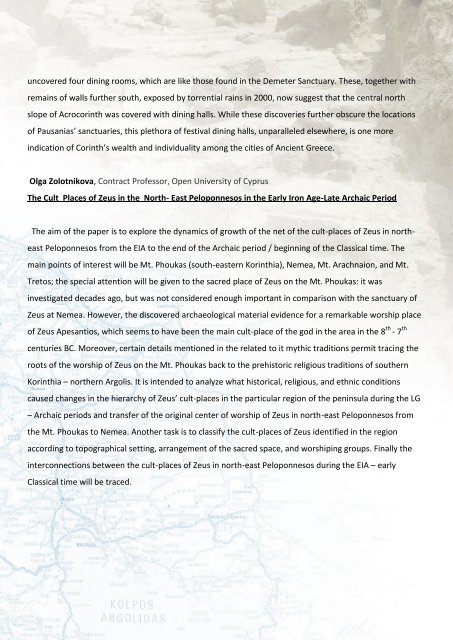ABSTRACTS - The American School of Classical Studies at Athens
ABSTRACTS - The American School of Classical Studies at Athens
ABSTRACTS - The American School of Classical Studies at Athens
Create successful ePaper yourself
Turn your PDF publications into a flip-book with our unique Google optimized e-Paper software.
uncovered four dining rooms, which are like those found in the Demeter Sanctuary. <strong>The</strong>se, together with<br />
remains <strong>of</strong> walls further south, exposed by torrential rains in 2000, now suggest th<strong>at</strong> the central north<br />
slope <strong>of</strong> Acrocorinth was covered with dining halls. While these discoveries further obscure the loc<strong>at</strong>ions<br />
<strong>of</strong> Pausanias’ sanctuaries, this plethora <strong>of</strong> festival dining halls, unparalleled elsewhere, is one more<br />
indic<strong>at</strong>ion <strong>of</strong> Corinth’s wealth and individuality among the cities <strong>of</strong> Ancient Greece.<br />
Olga Zolotnikova, Contract Pr<strong>of</strong>essor, Open University <strong>of</strong> Cyprus<br />
<strong>The</strong> Cult Places <strong>of</strong> Zeus in the North- East Peloponnesos in the Early Iron Age-L<strong>at</strong>e Archaic Period<br />
<strong>The</strong> aim <strong>of</strong> the paper is to explore the dynamics <strong>of</strong> growth <strong>of</strong> the net <strong>of</strong> the cult-places <strong>of</strong> Zeus in north-<br />
east Peloponnesos from the EIA to the end <strong>of</strong> the Archaic period / beginning <strong>of</strong> the <strong>Classical</strong> time. <strong>The</strong><br />
main points <strong>of</strong> interest will be Mt. Phoukas (south-eastern Korinthia), Nemea, Mt. Arachnaion, and Mt.<br />
Tretos; the special <strong>at</strong>tention will be given to the sacred place <strong>of</strong> Zeus on the Mt. Phoukas: it was<br />
investig<strong>at</strong>ed decades ago, but was not considered enough important in comparison with the sanctuary <strong>of</strong><br />
Zeus <strong>at</strong> Nemea. However, the discovered archaeological m<strong>at</strong>erial evidence for a remarkable worship place<br />
<strong>of</strong> Zeus Apesantios, which seems to have been the main cult-place <strong>of</strong> the god in the area in the 8 th - 7 th<br />
centuries BC. Moreover, certain details mentioned in the rel<strong>at</strong>ed to it mythic traditions permit tracing the<br />
roots <strong>of</strong> the worship <strong>of</strong> Zeus on the Mt. Phoukas back to the prehistoric religious traditions <strong>of</strong> southern<br />
Korinthia – northern Argolis. It is intended to analyze wh<strong>at</strong> historical, religious, and ethnic conditions<br />
caused changes in the hierarchy <strong>of</strong> Zeus’ cult-places in the particular region <strong>of</strong> the peninsula during the LG<br />
– Archaic periods and transfer <strong>of</strong> the original center <strong>of</strong> worship <strong>of</strong> Zeus in north-east Peloponnesos from<br />
the Mt. Phoukas to Nemea. Another task is to classify the cult-places <strong>of</strong> Zeus identified in the region<br />
according to topographical setting, arrangement <strong>of</strong> the sacred space, and worshiping groups. Finally the<br />
interconnections between the cult-places <strong>of</strong> Zeus in north-east Peloponnesos during the EIA – early<br />
<strong>Classical</strong> time will be traced.

















